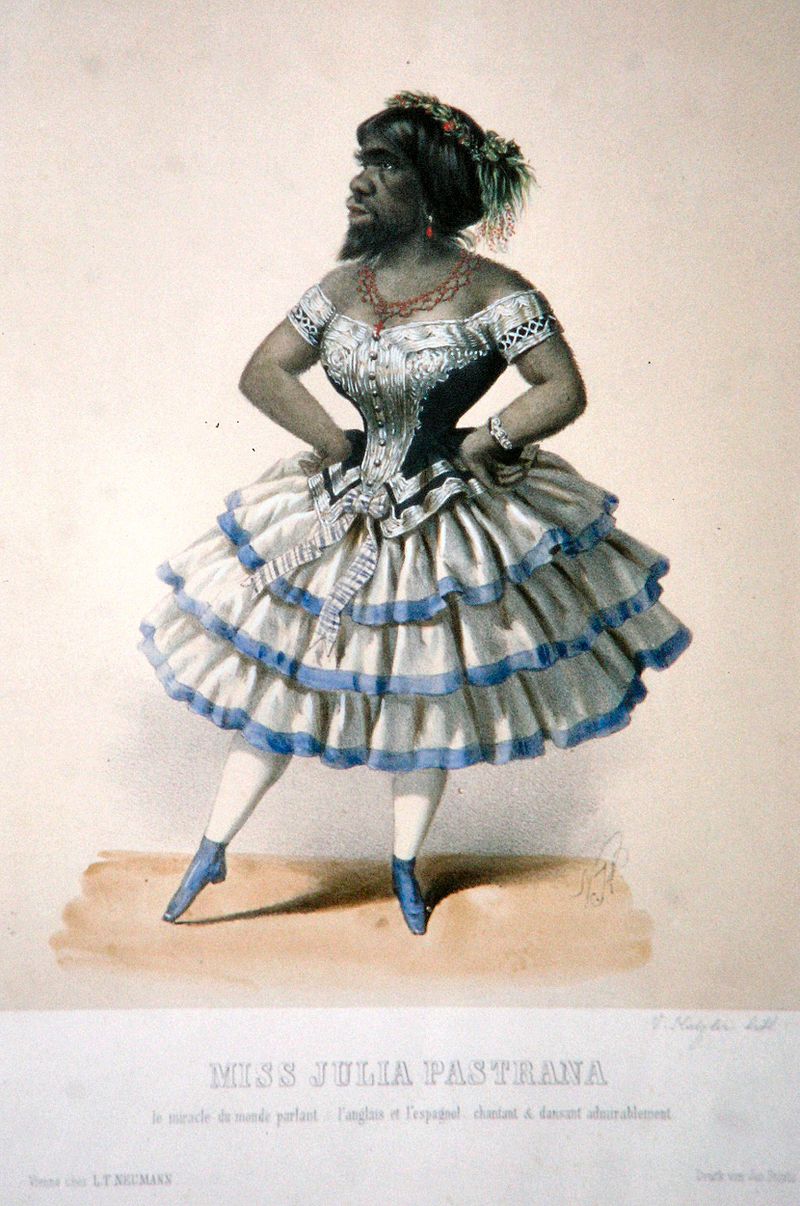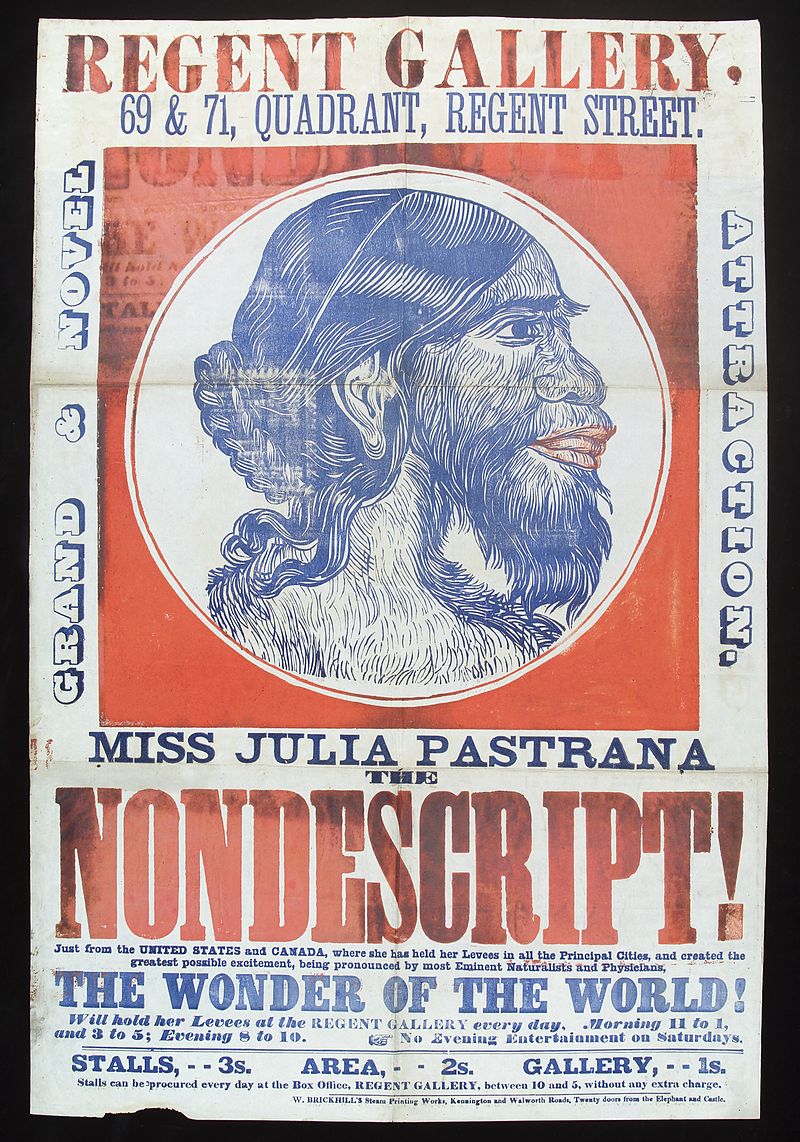
フリア・パストラーナ
Julia Pastrana, 1834-1860

Julia
Pastrana, Lithographie von Vinzenz Katzler (+ vor 1900)
☆ フリア・パストラーナ(1834年8月 - 1860年3月25日)は、多毛症であった19世紀の演奏家、歌手である。パストラーナは、1834年にシナロア州のどこかで生まれたメキシコ先住民の女 性である[1]。彼女は、末端多毛症(または汎発性産毛性多毛症[2])という遺伝的疾患を持って生まれ、顔と体はまっすぐな黒髪で覆われていた。耳と鼻 が異常に大きく、歯並びも不規則だった。後者の症状は、彼女の唇と歯茎を肥厚させる歯肉過形成という、生前は診断されていなかった珍しい病気によって引き 起こされた[2]。
| Julia Pastrana
(August 1834 – 25 March 1860) was a performer and singer during the
19th century who had hypertrichosis. Pastrana, an indigenous woman from
Mexico, was born in 1834, somewhere in the state of Sinaloa.[1] She was
born with a genetic condition, hypertrichosis terminalis (or
generalized hypertrichosis lanuginosa[2]); her face and body were
covered with straight black hair. Her ears and nose were unusually
large, and her teeth were irregular. The latter condition was caused by
a rare disease, undiagnosed in her lifetime, gingival hyperplasia,
which thickened her lips and gums.[2] |
ジュ
リア(スペイン語読みではフリア)・パストラーナ(1834年8月 -
1860年3月25日)は、多毛症であった19世紀の演奏家、歌手である。パストラーナは、1834年にシナロア州のどこかで生まれたメキシコ先住民の女
性である[1]。彼女は、末端多毛症(または汎発性産毛性多毛症[2])という遺伝的疾患を持って生まれ、顔と体はまっすぐな黒髪で覆われていた。耳と鼻
が異常に大きく、歯並びも不規則だった。後者の症状は、彼女の唇と歯茎を肥厚させる歯肉過形成という、生前は診断されていなかった珍しい病気によって引き
起こされた[2]。 |
| Life and career Multiple versions of Pastrana's early life exist. Literature produced by those who managed the freak shows she appeared in described her as belonging to a Native American tribe called "Root Diggers" whose members were similar to apes and lived in caves. In this version, it is said that a woman identified only as Mrs. Espinosa was kidnapped by the tribe and held in a cave and took Pastrana with her when she was able to escape. In another version, which is based on the words of indigenous villagers in Ocoroni, Mexico, Pastrana was a local girl whom they referred to as "wolf woman." In this version, Pastrana lived with her mother until her mother passed away, after which, her uncle sold her to the circus.[3] Both accounts claim that, at some point, she lived in the home of Pedro Sanchez, the then-governor of Sinaloa, and left the home in 1854.[4][5] According to Ireneo Paz, Francisco Sepúlveda, a customs official in Mazatlán, purchased Pastrana and brought her to the United States.[6] At first, Pastrana performed under the management of J.W. Beach, but in 1854, she eloped with Theodore Lent, marrying him in Baltimore, Maryland.[7] Lent took over her management, and they toured throughout the US and Europe. Pastrana was advertised as a hybrid between an animal and a human and worked in sideshows and freak shows under the stage names the "Baboon Lady",[8] the "Dog-faced Woman", the "Hairy Woman", the "Ape-faced Woman",[9] the "Ape Woman", the "Bear Woman", and "The Nondescript". During her performances, she demonstrated her intelligence and talent: singing, dancing, and interacting with the audience.[10] During a tour in Moscow, Pastrana gave birth to a son, with features similar to her own.[11] The child survived only three days, and Pastrana died of postpartum complications five days later. |
生い立ちとキャリア パストラーナの生い立ちについては複数の説が存在する。彼女が出演した見世物小屋を管理していた人たちによって作られた文献には、彼女が「ルート・ディ ガー」と呼ばれるネイティブ・アメリカンの部族に属しており、その部族は猿に似ていて洞窟に住んでいたと書かれている。このバージョンでは、エスピノーサ 夫人とだけ名乗る女性が部族に誘拐されて洞窟に監禁され、脱出できたときにパストラーナを連れて行ったとされている。別のバージョンでは、メキシコのオコ ロニに住む先住民の村人たちの言葉に基づいており、パストラーナは地元の少女で、彼女たちは 「狼女 」と呼んでいた。この説では、パストラーナは母親が亡くなるまで母親と暮らし、その後叔父にサーカスに売られた[3]。どちらの説も、ある時点で彼女は当 時のシナロア州知事であったペドロ・サンチェスの家で暮らし、1854年に家を出たと主張している[4][5]。 イレネオ・パスによると、マサトランの税関職員であったフランシスコ・セパルベダがパストラーナを購入し、アメリカに連れてきた[6]。当初、パストラー ナはJ.W.ビーチのマネージメントのもとで公演を行っていたが、1854年にセオドア・レントと駆け落ちし、メリーランド州ボルチモアで彼と結婚した [7]。パストラーナは動物と人間のハイブリッドとして宣伝され、「ヒヒの女」、[8] 「犬顔の女」、「毛深い女」、「猿顔の女」、[9] 「猿の女」、「熊の女」、「無名の女」という芸名で余興や見世物小屋で働いた。公演中、彼女は知性と才能を発揮し、歌い、踊り、観客と交流した[10]。 モスクワでのツアー中、パストラーナは自分とよく似た特徴を持つ息子を出産した[11]。子どもは3日しか生きられず、パストラーナは5日後に産後の合併症で亡くなった。 |
Medical examinations Julia Pastrana, "the nondescript", advertised for an exhibition of the famous bearded Lady. During her life, Pastrana's management arranged to have her examined by doctors and scientists, using their evaluations in advertisements to attract a larger audience. One doctor, Alexander B. Mott, M.D., certified that she was specifically the result of the mating of a human and an "Orangutan".[12] Another, Dr. S. Brainerd of Cleveland, declared that she was of a "distinct species".[13] Francis Buckland stated that she was "only a deformed Mexican Indian woman".[13] Samuel Kneeland, Jr., a comparative anatomist of the Boston Society of Natural History, declared that she was human and of Indian descent.[14] Charles Darwin discussed her case after her death, describing her as follows: "Julia Pastrana, a Spanish dancer, was a remarkably fine woman, but she had a thick masculine beard and a hairy forehead; she was photographed, and her stuffed skin was exhibited as a show; but what concerns us is, that she had in both the upper and lower jaw an irregular double set of teeth, one row being placed within the other, of which Dr. Purland took a cast. From the redundancy of the teeth her mouth projected, and her face had a gorilla-like appearance".[15] |
診察 「何の変哲もない」ジュリア・パストラーナは、有名な髭の貴婦人の展覧会の広告を出した。 パストラーナの経営陣は生前、彼女を医師や科学者に診察させ、その評価を広告に使って多くの観客を惹きつけた。医師の一人であるアレクサンダー・B・モッ ト医学博士は、彼女は人間と「オランウータン」の交配の結果であると断定し[12]、クリーブランドのS・ブレイナード博士は、彼女は「別種」であると宣 言した[13]。 フランシス・バックランドは、彼女は「奇形のメキシコ系インディアンの女性に過ぎない」と述べた[13]。 ボストン自然史協会の比較解剖学者であるサミュエル・ニーランド・ジュニアは、彼女は人間であり、インディアンの血を引いていると宣言した[14]。 チャールズ・ダーウィンは彼女の死後、彼女のケースについて次のように述べた: 「スペインのダンサー、ジュリア・パストラーナは驚くほど立派な女性だったが、男性的な濃いあごひげと毛深い額を持っていた。歯の冗長さから彼女の口は突 出し、顔はゴリラのようだった」[15]。 |
| After death Julia Pastrana, image from a 1900 book, showing her preserved remains After Pastrana's death, Lent sold her body and their son's body to Professor Sukolov of Moscow University who permanently preserved them. Her body was taxidermically preserved.[16] The process was a blend of taxidermy techniques and embalming chemicals.[17] Although generically referred to as a "mummy" by some authors, her preserved body was technically not a mummy because it was not mummified. Her body was "stuffed",[18] as noted by renowned naturalist and taxidermist Charles Darwin. After the bodies were preserved by Sukolov, Lent re-purchased them from him and began exhibiting them throughout Europe.[11] Lent later found another woman with similar features, married her and changed her name from Marie Bartel to Zenora Pastrana, becoming wealthy from her exhibition. For over a hundred years, the bodies of Pastrana and her son were displayed around the world in museums, circuses and amusement parks. They appeared in Norway in 1921 and toured the US as late as 1972. Later that year, a tour of Sweden drew considerable public opposition, leading to the bodies being withdrawn from public view.[11] Vandals broke into the storage facility in August 1976 and damaged the baby's body. The remains were consumed by mice. Julia's preserved body was stolen in 1979, but stored at the Oslo Forensic Institute after the body was reported to police but not identified. It was identified in 1990 and for many years rested in a sealed coffin at the Department of Anatomy, Oslo University. In 1994, the Norway Parliament recommended burying her remains, but the Minister of Sciences decided to keep them, so scientists could perform research. A special permit was required to gain access to her remains.[1] On 2 August 2012, it was reported in Aftenposten that Pastrana would finally be buried in Mexico at an unspecified date.[19] In February 2013, with the help of Sinaloa state governor Mario López Valdez, New York-based visual artist Laura Anderson Barbata, Norwegian authorities, and others, the body was turned over to the government of Sinaloa and her burial was planned.[2] Hundreds of people attended her Catholic funeral, and her remains were buried in a cemetery in Sinaloa de Leyva, a town near her birthplace.[20] Filmmaker Eva Aridjis filmed the burial for her feature documentary "Chuy, The Wolf Man", a portrait of a modern-day Mexican family with congenital hypertrichosis. |
死後 ジュリア・パストラーナ、1900年に出版された本の画像、彼女の遺体は保存されている。 パストラーナの死後、レントは彼女の遺体と息子の遺体をモスクワ大学のスコロフ教授に売却し、同教授は遺体を永久保存した。彼女の遺体は剥製にされ [16]、剥製の技術とエンバーミング(防腐処理)の化学薬品が融合された方法で保存された[17]。著名な博物学者で剥製師のチャールズ・ダーウィンが 指摘したように、彼女の遺体は「剥製」だった[18]。スコロフによって遺体が保存された後、レントは彼から遺体を再購入し、ヨーロッパ中に展示し始めた [11]。レントは後に似た特徴を持つ別の女性を見つけ、彼女と結婚し、彼女の名前をマリー・バーテルからゼノーラ・パストラーナに変え、彼女の展示に よって裕福になった。 100年以上もの間、パストラーナ親子の遺体は世界中の博物館、サーカス、遊園地に展示された。1921年にはノルウェーで展示され、1972年にはアメ リカを巡回した。1976年8月、保管施設に破壊者が侵入し、赤ん坊の遺体が損壊した。遺体はネズミに食われてしまった。ユリアの遺体は1979年に盗ま れたが、警察に届けられたものの身元が確認されなかったため、オスロ法医学研究所に保管された。1990年に身元が確認され、長年オスロ大学解剖学教室の 密閉された棺に安置されていた。1994年、ノルウェー議会は遺体の埋葬を勧告したが、科学大臣は科学者が研究を行うために遺体を保管することを決定し た。遺骨に立ち入るには特別な許可が必要だった[1]。 2012年8月2日、アフテンポステン紙は、パストラーナは最終的にメキシコに埋葬されるだろうと報じた[19]。2013年2月、シナロア州知事マリ オ・ロペス・バルデス、ニューヨーク在住のビジュアルアーティスト、ローラ・アンダーソン・バルバタ、ノルウェー当局などの協力により、遺体はシナロア州 政府に引き渡され、彼女の埋葬が計画された。 [先天性多毛症を持つ現代のメキシコ人家族を描いた長編ドキュメンタリー『Chuy, The Wolf Man(狼男チュイ)』のために、映画監督のエヴァ・アリジスが埋葬の様子を撮影した。 |
| Theatre A musical Pastrana by Australian writers Allan McFadden and Peter Northwood was performed by Melbourne's Church Theatre in 1989.[21][22] The production was nominated for five Melbourne Green Room Awards. A play based on Pastrana's life, The True History of the Tragic Life and Triumphant Death of Julia Pastrana, the Ugliest Woman in the World (1998) was written by Shaun Prendergast. A 2003 Texas production of the play staged by Kathleen Anderson Culebro, sister of Laura Anderson Barbata, led to the campaign by Anderson Barbata to repatriate Pastrana's remains from Norway to Mexico.[2] Film Marco Ferreri's film The Ape Woman (1964) is based on Pastrana's life story. On 14 October 2013 the in-development movie "Velvet" was announced, based on the life and experiences of Julia Pastrana, and from an original screenplay by Celso García and Francisco Payó González. "Velvet" is directed by Celso García and is an international production with the support of various personalities behind and in front of the camera. The announcement appeared in an article published in Mexican newspaper "Mural", member of the editorial group Reforma.[citation needed] Music The Ass Ponys wrote and recorded the song Julia Pastrana about her life on their 1993 album Grim. The musical supergroup Apparatjik released a single titled "Julia" on March 20, 2020, accompanied by a lyric video. |
劇場 オーストラリアの作家アラン・マクファデンとピーター・ノースウッドによるミュージカル『パストラーナ』は、1989年にメルボルンのチャーチ・シアターで上演された[21][22]。この作品は、メルボルン・グリーンルーム賞の5部門にノミネートされた。 パストラーナの人生を基にした戯曲『The True History of the Tragic Life and Triumphant Death of Julia Pastrana, the Ugliest Woman in the World』(1998年)はショーン・プレンダーガストによって書かれた。2003年、ローラ・アンダーソン・バルバタの妹であるキャスリーン・アン ダーソン・キュレブロがテキサスで上演したことがきっかけとなり、アンダーソン・バルバタはパストラーナの遺骨をノルウェーからメキシコに送還する運動を 展開した[2]。 映画 マルコ・フェレーリの映画『猿の女』(1964年)は、パストラーナの生涯を題材にしている。 2013年10月14日、ジュリア・パストラーナの人生と経験に基づき、セルソ・ガルシアとフランシスコ・パヨ・ゴンサレスのオリジナル脚本による開発中 の映画『Velvet』が発表された。「ベルベット』は、セルソ・ガルシアが監督を務め、カメラの前でも後ろでも様々な人物の協力を得て国際的に製作され る。この発表は、編集グループReformaのメンバーであるメキシコの新聞 「Mural 」に掲載された記事に掲載された[要出典]。 音楽 アス・ポニーズは、1993年のアルバム『Grim』にジュリア・パストラーナの人生を歌った曲を書き、レコーディングした。 音楽スーパーグループApparatjikは、2020年3月20日に 「Julia 」というタイトルのシングルをリリックビデオ付きでリリースした。 |
| Bearded lady Alice Elizabeth Doherty, "The Minnesota Woolly Girl" Annie Jones, "The Bearded Woman" Krao Farini, "The Missing Link" Ferriman-Gallwey score Negro of Banyoles, example of a taxidermied human Repatriation of human remains Sarah Baartman Human Zoo |
髭を生やした女性 アリス・エリザベス・ドハーティ、"ミネソタの毛糸女」 アニー・ジョーンズ、"ヒゲの女」 クラオ・ファリーニ、"ミッシング・リンク」 フェリマン・ガルウェイの楽譜 バニョレスの黒人、剥製にされた人間の例 遺体の引き渡し サラ・バートマン 人間動物園 |
| https://en.wikipedia.org/wiki/Julia_Pastrana |
|
リ ンク
文 献
そ の他の情報
Copyleft, CC, Mitzub'ixi Quq Chi'j, 1996-2099
☆
 ☆
☆